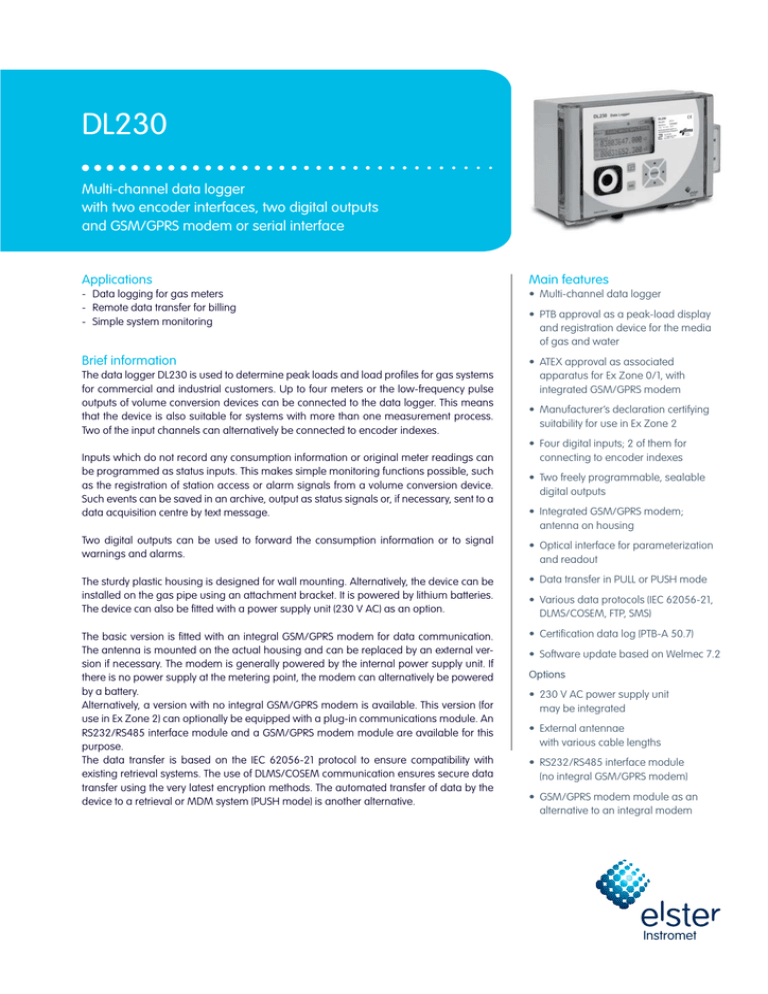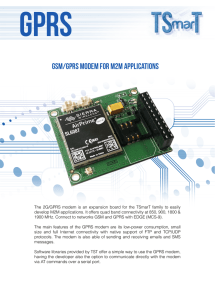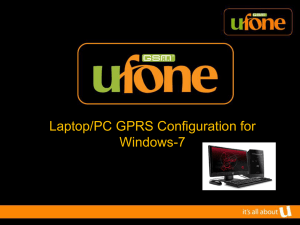
DL230
Multi-channel data logger
with two encoder interfaces, two digital outputs
and GSM/GPRS modem or serial interface
Applications
Main features
- Data logging for gas meters
- Remote data transfer for billing
- Simple system monitoring
• Multi-channel data logger
Brief information
• ATEX approval as associated
apparatus for Ex Zone 0/1, with
integrated GSM/GPRS modem
The data logger DL230 is used to determine peak loads and load profiles for gas systems
for commercial and industrial customers. Up to four meters or the low-frequency pulse
outputs of volume conversion devices can be connected to the data logger. This means
that the device is also suitable for systems with more than one measurement process.
Two of the input channels can alternatively be connected to encoder indexes.
Inputs which do not record any consumption information or original meter readings can
be programmed as status inputs. This makes simple monitoring functions possible, such
as the registration of station access or alarm signals from a volume conversion device.
Such events can be saved in an archive, output as status signals or, if necessary, sent to a
data acquisition centre by text message.
Two digital outputs can be used to forward the consumption information or to signal
warnings and alarms.
• PTB approval as a peak-load display
and registration device for the media
of gas and water
• Manufacturer’s declaration certifying
suitability for use in Ex Zone 2
• Four digital inputs; 2 of them for
connecting to encoder indexes
• Two freely programmable, sealable
digital outputs
• Integrated GSM/GPRS modem;
antenna on housing
• Optical interface for parameterization
and readout
The sturdy plastic housing is designed for wall mounting. Alternatively, the device can be
installed on the gas pipe using an attachment bracket. It is powered by lithium batteries.
The device can also be fitted with a power supply unit (230 V AC) as an option.
• Data transfer in PULL or PUSH mode
The basic version is fitted with an integral GSM/GPRS modem for data communication.
The antenna is mounted on the actual housing and can be replaced by an external version if necessary. The modem is generally powered by the internal power supply unit. If
there is no power supply at the metering point, the modem can alternatively be powered
by a battery.
Alternatively, a version with no integral GSM/GPRS modem is available. This version (for
use in Ex Zone 2) can optionally be equipped with a plug-in communications module. An
RS232/RS485 interface module and a GSM/GPRS modem module are available for this
purpose.
The data transfer is based on the IEC 62056-21 protocol to ensure compatibility with
existing retrieval systems. The use of DLMS/COSEM communication ensures secure data
transfer using the very latest encryption methods. The automated transfer of data by the
device to a retrieval or MDM system (PUSH mode) is another alternative.
• Certification data log (PTB-A 50.7)
• Various data protocols (IEC 62056-21,
DLMS/COSEM, FTP, SMS)
• Software update based on Welmec 7.2
Options
• 230 V AC power supply unit
may be integrated
• External antennae
with various cable lengths
• RS232/RS485 interface module
(no integral GSM/GPRS modem)
• GSM/GPRS modem module as an
alternative to an integral modem
Instromet
DL230: Multi-channel data logger with two ENCODER interfaces, two digital outputs and GSM/GPRS modem or serial interface
Metrological approval
Outputs
Power supply
The data logger DL230 has PTB approval
as a peak-load display and registration
device with reference to PTB Requirements
50.7 (for gas and water meters). The peakload values formed by the device and the
recorded consumption values or meter
readings can therefore be used for billing
commercial and industrial customers.
Two digital outputs are available to forward
consumption, alarm or status information;
galvanic isolation is also provided.
A lithium battery provides sufficient power for the data logger to run for at least
8 years. Two batteries are required if two
encoder indexes are connected. As an option, a power supply unit can additionally
be used to supply power for both the device
and the integrated GSM/GPRS modem. At
least one device battery always remains in
the device to guarantee the power supply
even if the external mains power supply
fails. If there is no way to connect the device
to the 230 V AC mains power supply at the
metering point, the integrated GSM/GPRS
modem can also be powered by a battery.
The function of the inputs and outputs can
be programmed individually. Naturally,
both the inputs and outputs can be given
software protection and can be sealed to
prevent tampering and changes if the device is used for fiscal purposes.
Display and operation
All current values, parameters and archive
data can be viewed on a large graphics
display. This display is
illuminated even in battery mode and therefore
easy to read without an
additional light source,
even in adverse installation conditions. Its operation is based on Windows
Explorer making navigation very straightforward.
An additional function
key enables the user to
return to the main screen,
clear the status register or freeze the display
with ease. Symbols provide additional information about the remaining
capacity of the device batteries and the
reception strength of the modem, for example.
Connection to the meter
The data logger supports the connection of
up to four credit meters with low-frequency
pulse generators. Two inputs can be used
to connect Absolute ENCODER indexes.
All conventional interfaces and protocols
are supported. Inputs which are not used
to record volumes can be used as status
inputs.
2
Installation
Archiving
In addition to the monthly and measuring
period archives required for billing purposes, the DL230 also provides additional,
flexibly configurable archives. The content and structure of the invoice-relevant
archives is predefined with reference to
the PTB approval as a peak-load display
and registration device. The content of the
flexible archives and the events triggering
registration can be freely defined. Four of
these flexible archives are preset as daily
archives for inputs 1 – 4 in the basic configuration.
The plastic housing is designed for mounting on a wall. As an option, an attachment
bracket can be supplied so that the device
can be installed on a pipeline. Sturdy hinges secure the housing cover when connecting the inputs and outputs, changing the
batteries or retrofitting the power supply
unit. The standard antenna on the GSM/
GPRS modem is mounted on the exterior
of the housing and is also protected from
damage by the housing cover. If the reception field strength at the metering point is
inadequate, an external antenna can be
connected as an alternative. Antennae
with various cable lengths are available for
this purpose. Additional sealing facilities
make it possible to prevent tampering and
the unauthorized opening of the housing.
ATEX approval
The device version with integral GSM/GPRS
modem has ATEX approval as associated
apparatus for Ex Zone 0/1 and is supplied
with a Manufacturer’s declaration certifying
suitability for use in Ex Zone 2.This means
that the inputs can also be connected to
gas meters or volume conversion devices
in potentially explosive atmospheres without additional Ex-barrier modules having
to be used. The version with a plug-in communications module can only be used in
the safe zone and in Ex Zone 2.
Product data sheet
Data communication
The integral GSM/GPRS modem and
the GSM/GPRS modem module support data communication in both PULL
and PUSH mode. The data can be
read in the GPRS network using the
“TCPServ” (PULL) application at a data acquisition centre using TCP/IP. Alternatively, the
“ComFTP” (PUSH) application can be used
to transfer archive and process data from
the DL230 to an FTP server. Both modes of
operation ensure that the recorded data is
made available securely, promptly and at
low cost to downstream systems.
Not simultaneously but in addition, the
data can also be read in both modes by a
telephone call via the GSM network (CSD).
For transfers using the PULL principle, either
the IEC 62056-21 data protocol or DLMS/
COSEM communication may be used. The
DLMS/COSEM protocol allows the data
transfer to be signed and encrypted.
In addition, the DL230 allows text messages to be sent in both operating modes. The
event that triggers the message, its content
and the recipients can be freely defined.
This can be done for up to 10 independent
events. This function can also be used to
monitor freely definable states and events
in small gas measurement systems, such
as the failure of the external voltage supply, reaching the peak load prematurely or
access to the station using a simple door
contact. The text-messaging function also
provides a simple way to transfer meter
readings, for example, to the end customer’s mobile devices.
Communications module
As an alternative to the basic version, the
device can also be used without an integral GSM/GPRS modem. In this version,
an interface module pursuant to RS232/
RS485 or a GSM/GPRS modem module
can be installed in the device. The device
is configured using the parameterization
software enSuite. An external communications device (e.g. analogue modem) can be
connected to the RS232/RS485 interface
module.
Software update
The DL230 supports a software update in
accordance with the WELMEC 7.2 Software
Guide. This can be carried out both via the
optical interface and by remote data transfer using DLMS/COSEM communication
and in compliance with security standards
(using encryption). This means that the device can be kept up to date even after it has
been installed.
Flexible in data communication – PULL and PUSH (in the version with GSM/GPRS modem)
Data acquisition centre
Station
FTP-Server
ComFTP application* PUSH
FTP
GPRS – TCP/IP – ABL/MPX format
Transfer of archives and process data
E-Mail
HTTP
DL230
TCPServ application* PULL
VPN
Remote meter reading
(TCP-Client)
GPRS – TCP/IP – IEC 62056-21 or DLMS/COSEM
Transparent connection – reading archives
GSM/CSD – IEC 62056-21 or DLMS/COSEM
Transparent connection – reading archives
Text messaging
acquisition centre
GSM/SMS
Transfer of messages with flexible content
* alternative use
3
DL230: DL230: Multi-channel data logger with two ENCODER interfaces, two digital outputs and GSM/GPRS modem or serial interface
Technical data
Order number
83480080
Housing
Plastic with cable glands
Dimensions
W 175 mm x H 85 mm x L 250 mm (incl. cable glands)
Weight
1.3 kg (weight incl. one device battery and power supply unit)
Protection class
IP 65 to EN 60529
Ambient conditions
Temperature: -25 °C to +60 °C
Max. humidity: 93%, non-condensing
ATEX approval
Basic version: Associated apparatus for Ex Zone 0/1 and Manufacturer’s declaration certifying suitability
for use in Ex Zone 2 II (1) G [Ex ia Ga] IIC and II 3 (3) G Ex nA [ic] IIC T6 Gc markings
In the version with no integral GSM/GPRS modem: Manufacturer’s declaration certifying suitability for use
in Ex Zone 2 II 3 (3) G Ex nA [ic] IIC T6 Gc marking
PTB approval
PTB approval 7.732 / 14.50 to PTB-A 50.7
as peak-load display and registration device
Inputs
4 inputs (intrinsically safe), max. input frequency: 10 Hz
- Pulse or status inputs
- Alternatively, 2 inputs can also be connected to an encoder index (Namur, SCR/SCR+)
Outputs
2 digital transistor outputs (Umax = 30 V DC, Imax = 100 mA); can be used freely as
- Pulse output (max. output frequency: 4 Hz)
- Status output
- Time synchronization output
The outputs can be galvanically isolated using a switch
(not an approved galvanic isolation to ATEX).
Display
Dot matrix display, 200 x 80 pixels, backlit
All parameters, settings and archived values can be displayed.
Control panel
7-key plastic-coated keypad
Device power supply
One or two lithium batteries, 3.6 V, 13 Ah
Modem power supply
One lithium battery, 3.6 V, 13 Ah; alternatively with power supply unit (optional)
Power supply unit (optional)
Primary: 230 V AC, power consumption 5 W
Secondary: 2 x 3.6 V to supply the device and modem
Data interfaces
- Optical interface to IEC 62056-21
for parameterization and reading of archives
- Serial interface RS232/RS485 as a plug-in module
optional only for the version with no integral modem
(information on how to use the RS485 interface can be found in the application manual)
Modem
(integral or as a plug-in module)
Integrated GSM/GPRS/EDGE modem (quad band 850/900/1800/1900 MHz)
Antenna on the housing in a protected position
Alternatively, an external antenna can be connected.
Data communication (applications)
ComFTP:
TCPServ:
GSM/CSD:
GSM/SMS:
Data protocols*2
-
automated data transfer to an FTP server (PUSH)*1
addressing using fixed IP addresses in a VPN (PULL)
readout using conventional modem technology (PULL)
transfer of data and messages via text messaging (PUSH)
IEC 62056-21
DLMS/COSEM (data encryption based on standards AES-128 and Galois/Counter Mode)
FTP*3
SMS*3
*1 The ComFTP application may be used as an alternative to the TCPServ application (standard). If required, this must be specified when ordering the device.
*2 Details of implemented function range of the listed protocols can be provided on request
*3 Only with integral GSM/GPRS modem or with GSM/GPRS modem module
Your contacts
Germany
Elster GmbH
Steinern Str. 19 - 21
55252 Mainz-Kastel
T +49 6134 605 0
F +49 6134 605 223
www.elster-instromet.com
info@elster-instromet.com
DL230 EN02
A22.02.2016
Belgium
Elster NV/SA
Rijkmakerlaan 9
2910 Essen
T +32 3 670 0700
F +32 3 667 6940
www.elster-instromet.com
sales@elster-instromet.com
Singapore
Elster-Instromet Sdn. Bhd. (Singapore Branch)
29 Tai Seng Avenue
#06-05A Natural Cool Lifestyle Hub
Singapore 534119
T +65 6247 7728
F +65 6848 9003
sales-SG@elster.com
73030138
Copyright 2014 Elster GmbH
All rights reserved.
Subject to change without prior notice




